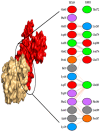In silico modeling of the interaction between TEX19 and LIRE1, and analysis of TEX19 gene missense SNPs
- PMID: 34036740
- PMCID: PMC8372073
- DOI: 10.1002/mgg3.1707
In silico modeling of the interaction between TEX19 and LIRE1, and analysis of TEX19 gene missense SNPs
Abstract
Background: Testis expressed 19 (TEX19) is a specific human stem cell gene identified as cancer-testis antigen (CTA), which emerged as a potential therapeutic drug target. TEX19.1, a mouse paralog of human TEX19, can interact with LINE-1 retrotransposable element ORF1 protein (LIRE1) and subsequently restrict mobilization of LINE-1 elements in the genome.
Aim: This study aimed to predict the interaction of TEX19 with LIRE1 and analyze TEX19 missense polymorphisms. TEX19 model was generated using I-TASSER and the interaction between TEX19 and LIRE1 was studied using the HADDOCK software.
Methods: The stability of the docking formed complex was studied through the molecular dynamic simulation using GROMACS. Missense SNPs (n=102) of TEX19 were screened for their potential effects on protein structure and function using different software.
Results: Outcomes of this study revealed amino acids that potentially stabilize the predicted interaction interface between TEX19 and LIRE1. Of these SNPs, 37 were predicted to play a probably damaging role for the protein, three of them (F35S, P61R, and E55L) located at the binding site of LIRE1 and could disturb this binding affinity.
Conclusion: This information can be verified by further in vitro and in vivo experimentations and could be exploited for potential therapeutic targets.
Keywords: LINE-1; MD simulation; SNPs analysis; TEX19; molecular docking.
© 2021 The Authors. Molecular Genetics & Genomic Medicine published by Wiley Periodicals LLC.
Conflict of interest statement
The authors have declared no conflict of interest.
Figures





Similar articles
-
TEX19 promotes ovarian carcinoma progression and is a potential target for epitope vaccine immunotherapy.Life Sci. 2020 Jan 15;241:117171. doi: 10.1016/j.lfs.2019.117171. Epub 2019 Dec 13. Life Sci. 2020. PMID: 31843525
-
Mobilization of LINE-1 retrotransposons is restricted by Tex19.1 in mouse embryonic stem cells.Elife. 2017 Aug 14;6:e26152. doi: 10.7554/eLife.26152. Elife. 2017. PMID: 28806172 Free PMC article.
-
Tex19, a mammalian-specific protein with a restricted expression in pluripotent stem cells and germ line.Stem Cells. 2008 Mar;26(3):734-44. doi: 10.1634/stemcells.2007-0772. Epub 2007 Dec 20. Stem Cells. 2008. PMID: 18096721
-
Comprehensive in silico screening and molecular dynamics studies of missense mutations in Sjogren-Larsson syndrome associated with the ALDH3A2 gene.Adv Protein Chem Struct Biol. 2020;120:349-377. doi: 10.1016/bs.apcsb.2019.11.004. Epub 2020 Feb 4. Adv Protein Chem Struct Biol. 2020. PMID: 32085885 Review.
-
Genetic variation and RNA binding proteins: tools and techniques to detect functional polymorphisms.Adv Exp Med Biol. 2014;825:227-66. doi: 10.1007/978-1-4939-1221-6_7. Adv Exp Med Biol. 2014. PMID: 25201108 Review.
Cited by
-
BARD1 mystery: tumor suppressors are cancer susceptibility genes.BMC Cancer. 2022 Jun 1;22(1):599. doi: 10.1186/s12885-022-09567-4. BMC Cancer. 2022. PMID: 35650591 Free PMC article. Review.
-
TEX19 increases the levels of CDK4 and promotes breast cancer by disrupting SKP2-mediated CDK4 ubiquitination.Cancer Cell Int. 2024 Jun 12;24(1):207. doi: 10.1186/s12935-024-03384-4. Cancer Cell Int. 2024. PMID: 38867223 Free PMC article.
-
Association of SNPs within TMPRSS6 and BMP2 genes with iron deficiency status in Saudi Arabia.PLoS One. 2021 Nov 15;16(11):e0257895. doi: 10.1371/journal.pone.0257895. eCollection 2021. PLoS One. 2021. PMID: 34780475 Free PMC article.
-
Identification and Characterization of Novel Mutations in Chronic Kidney Disease (CKD) and Autosomal Dominant Polycystic Kidney Disease (ADPKD) in Saudi Subjects by Whole-Exome Sequencing.Medicina (Kaunas). 2022 Nov 16;58(11):1657. doi: 10.3390/medicina58111657. Medicina (Kaunas). 2022. PMID: 36422197 Free PMC article.
References
-
- Al‐Amer, O., Hawasawi, Y., Oyouni, A. A. A., Alshehri, M., Alasmari, A., Alzahrani, O., & Aljohani, S. A. S. (2020). Study the association of transmembrane serine protease 6 gene polymorphisms with iron deficiency status in Saudi Arabia. Gene, 751, 144767. - PubMed
-
- Alzahrani, F. A., Ahmed, F., Sharma, M., Rehan, M., Mahfuz, M., Baeshen, M. N., Hawsawi, Y., Almatrafi, A., Alsagaby, S. A., Kamal, M. A., Warsi, M. K., Choudhry, H., & Jamal, M. S. (2020). Investigating the pathogenic SNPs in BLM helicase and their biological consequences by computational approach. Scientific Reports, 10, 12377. - PMC - PubMed
-
- Berman, H. M., Battistuz, T., Bhat, T. N., Bluhm, W. F., Bourne, P. E., Burkhardt, K., Feng, Z., Gilliland, G. L., Iype, L., & Jain, S. (2002). The protein data bank. Acta Crystallographica Section D: Biological Crystallography, 58, 899–907. - PubMed
Publication types
MeSH terms
Substances
LinkOut - more resources
Full Text Sources
Other Literature Sources
Molecular Biology Databases
Research Materials

